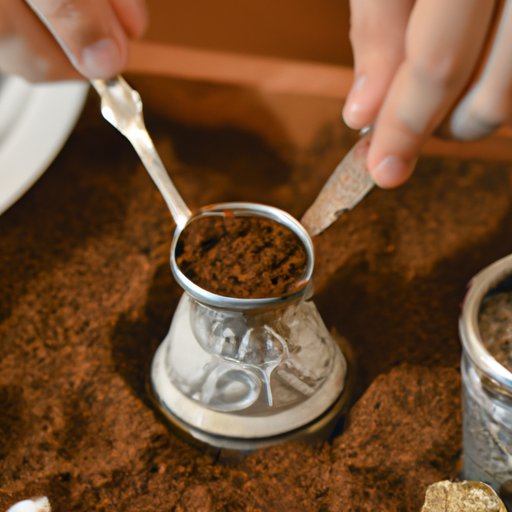Introduction
If you’ve ever visited the Middle East or other parts of the world where Turkish coffee is popular, you know it’s an experience like no other. From the aroma of freshly ground coffee beans to the ritual of preparing and drinking it, Turkish coffee is a unique and ancient tradition. In this article, we explore the history, process, and benefits of Turkish coffee and explain how to brew the perfect cup.
What is Turkish Coffee?
Turkish coffee is a type of coffee made by boiling finely ground coffee beans with water and sugar in a small pot called a cezve. The coffee is served unfiltered, resulting in a thick, intense flavor that’s beloved in many cultures around the world. Turkish coffee is often enjoyed with a glass of cold water to balance out the bitterness.
History of Turkish Coffee
The exact origin of Turkish coffee is unknown, but it’s believed to have been invented in the 1500s in what is now Turkey. It quickly spread throughout the Middle East, North Africa, and Eastern Europe, becoming an integral part of many cultures’ traditions and customs. Today, it remains a popular drink in many parts of the world and is still made using traditional methods.

Exploring the Process of Making Turkish Coffee
Brewing Turkish coffee is a surprisingly simple process that only requires a few steps. Here’s how to make your own cup of Turkish coffee:
Preparing the Coffee Grounds
The first step is to grind the coffee beans very finely, almost to a powder-like consistency. This ensures the coffee is strong and flavorful. You can use any type of coffee bean for Turkish coffee, but some types work better than others. Arabica beans are usually preferred because they’re less acidic and have a smoother flavor.
Boiling Water and Coffee Together
Once the coffee grounds are ready, you’ll need to place them in a cezve along with water and sugar (if desired). Place the cezve over low heat and wait for the mixture to come to a boil. Once it reaches a boil, reduce the heat and allow the coffee to simmer for a few minutes before removing it from the heat.
Serving the Coffee
After the coffee has finished brewing, it’s time to serve it. Pour the coffee into small cups and enjoy it with a glass of cold water. If desired, you can add a pinch of cinnamon or other spices for extra flavor.

A Guide to Brewing the Perfect Cup of Turkish Coffee
Brewing the perfect cup of Turkish coffee takes practice, but with these tips you’ll be able to make a delicious cup every time:
Choosing the Right Equipment
The most important piece of equipment for brewing Turkish coffee is the cezve. This small pot is designed specifically for making Turkish coffee, and it’s essential for achieving the right flavor and texture. You’ll also need a stovetop or other heat source, as well as small cups for serving.
Measuring the Ingredients
It’s important to measure the ingredients carefully when making Turkish coffee. For each cup of coffee, you’ll need 1 tablespoon of ground coffee and 1 cup of cold water. You can also add sugar if desired, but this isn’t necessary. Start with a small amount and adjust to taste.
Adding the Sugar
If you choose to add sugar, it’s best to do so before adding the coffee grounds. This will help the sugar dissolve more easily and ensure the sweetness is evenly distributed throughout the coffee. You can add up to 2 tablespoons of sugar per cup.
Stirring the Coffee
Once the coffee and water have been combined, stir the mixture gently but thoroughly. This will help to ensure the flavors are evenly distributed. Be careful not to stir too vigorously, as this can disrupt the foam that forms on top of the coffee.
Finishing the Brew
When the coffee has reached a gentle boil, reduce the heat and allow it to simmer for 3-4 minutes. Do not leave it on the heat for too long, as this can result in a bitter flavor. Once the coffee is finished brewing, remove it from the heat and pour it into small cups.
How to Enjoy the Best Flavors of Turkish Coffee
To get the most out of your Turkish coffee, you’ll want to consider the type of coffee beans you use and the roast level. Different types of beans have different characteristics and flavors, so experiment to find the one that best suits your tastes.
Different Types of Coffee Beans
There are many types of coffee beans available, and each one has its own unique flavor profile. Arabica beans are usually preferred for Turkish coffee, but you can also try Robusta beans or a blend of both. Experiment with different types to find the one that best suits your preferences.
Flavoring the Coffee
You can add a variety of spices and flavors to your Turkish coffee to enhance its flavor. Cinnamon is a popular choice, but you can also try cardamom, cloves, nutmeg, or even orange peel for a unique twist. Try adding a pinch of your favorite spice to the coffee grounds before brewing.
Selecting the Right Roast
The roast level of your coffee beans will also affect the flavor of your Turkish coffee. Light roasts tend to be more acidic and have a brighter flavor, while dark roasts are richer and more full-bodied. Choose the roast level that best suits your taste.

The Benefits of Drinking Turkish Coffee
In addition to its unique flavor, Turkish coffee offers a number of health and mental benefits. Here are just a few of the benefits of drinking Turkish coffee:
Health Benefits
Drinking Turkish coffee can provide several health benefits. It’s a good source of antioxidants, which can help reduce inflammation and protect against certain diseases. It also contains caffeine, which can boost energy levels and improve concentration. Finally, it’s low in calories, making it a great choice for those watching their weight.
Mental Benefits
Not only is Turkish coffee good for your physical health, it can also benefit your mental health. Caffeine can help improve mood and focus, while the ritual of making and drinking the coffee can be a calming and relaxing experience. Plus, enjoying a cup of Turkish coffee with friends and family can be a great way to connect and bond.

Understanding the Different Types of Turkish Coffee
Turkish coffee comes in a variety of styles, each with its own unique flavor and texture. Here are some of the most popular types of Turkish coffee:
Thick vs. Thin
Turkish coffee can be thick or thin, depending on how much ground coffee is used. Thick coffee is made with more coffee grounds and has a stronger flavor, while thin coffee is made with less grounds and has a lighter flavor.
Sweet vs. Unsweetened
Turkish coffee can be sweetened with sugar or left unsweetened. Sweetened coffee is usually preferred, but you can experiment with different levels of sweetness to find the one that best suits your tastes.
Light vs. Dark Roasts
As mentioned earlier, the roast level of your coffee beans will also affect the flavor of your Turkish coffee. Light roasts tend to be more acidic and have a brighter flavor, while dark roasts are richer and more full-bodied.
Revealing the Secrets of Turkish Coffee Preparation
Making the perfect cup of Turkish coffee requires a bit of finesse, but with these tips you’ll be able to master the art of coffee preparation:
Using the Right Water
The quality of the water you use will have a big impact on the flavor of your coffee. Use filtered or bottled water for the best results. Tap water can also be used, but it may alter the flavor of the coffee.
Taking Your Time
Brewing Turkish coffee takes patience and practice. Don’t rush the process, as this can lead to a bitter flavor. Allow the coffee to simmer for the recommended time and take your time stirring it to ensure the flavors are evenly distributed.
Adding Spices
Adding spices to your Turkish coffee can help to enhance its flavor. Common spices include cinnamon, cardamom, cloves, and nutmeg. Experiment with different combinations to find the ones that best suit your tastes.
Uncovering the Rituals and Customs Surrounding Turkish Coffee
In addition to its unique flavor, Turkish coffee has a long history of rituals and customs associated with it. Here are some of the most common rituals and customs surrounding Turkish coffee:
Presentation
Presentation is an important part of the Turkish coffee experience. When serving Turkish coffee, it’s customary to present it on a tray with a glass of cold water and a small plate of sweets. This helps to enhance the flavor and adds a touch of elegance to the experience.
Serving Etiquette
When drinking Turkish coffee, there are certain etiquette rules to follow. It’s polite to offer the first cup to the oldest person in the room, and then proceed in descending order of age. Also, it’s considered rude to refuse a cup of Turkish coffee when offered.
Socializing over Coffee
Drinking Turkish coffee is more than just a beverage—it’s a social activity. Enjoying a cup of coffee with friends and family is a great way to connect and bond. It’s also a popular activity among business associates, as it provides an opportunity to relax and discuss important matters.
Conclusion
Turkish coffee is a centuries-old tradition with a rich history and unique flavor. Not only is it delicious, it also offers a number of health and mental benefits. Whether you’re looking to explore the culture or simply want to make a delicious cup of coffee, Turkish coffee is sure to satisfy. With these tips, you’ll be able to make the perfect cup of Turkish coffee every time.
(Note: Is this article not meeting your expectations? Do you have knowledge or insights to share? Unlock new opportunities and expand your reach by joining our authors team. Click Registration to join us and share your expertise with our readers.)
